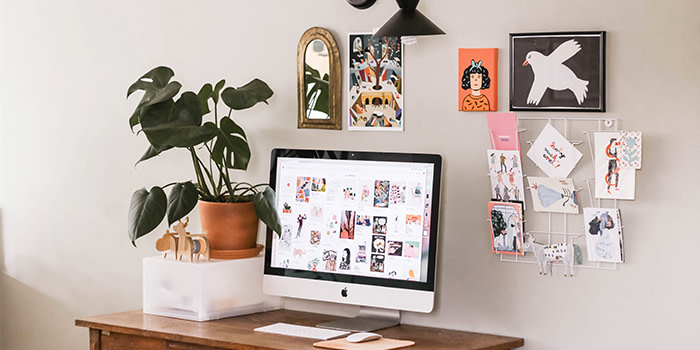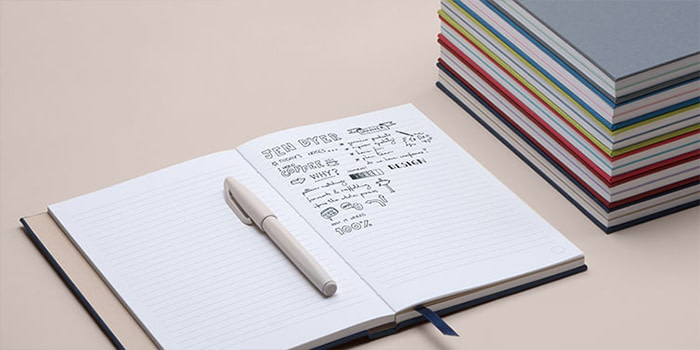Tips on how to work from home effectively

Whether you’re an employer or an employee, here are some 10 tips to effectively work from home.
Get into the right mindset for work
Have you been working remotely? Or has it sometimes felt more like you’re remotely working? While people have adapted quickly to changing circumstances, getting the most out of a new WFH workspace can still take some extra discipline and consideration.
It’s hardly surprising. Offices have all those subtle cues and associations that get us into a productive frame of mind. WFH efficiency relies on different factors than office work. While your remote working space at home is in a location you (hopefully!) associate with relaxation and fun. Equally, a lack of structure can lead to overworking and forgetting those all-important screen breaks.
The answer? Develop a homeworking routine that sets you up for a day’s work, not a day snuggled up on the couch with your laptop while Netflix plays in the background, or working late into the night when you could be chilling out.
Get dressed for success
There’s no need to don a suit and shine your shoes for a day of remote work – although if that does the trick for you, we definitely won’t argue – but there’s a lot of power in wearing something that makes you feel energized and capable. Pay attention to what you wear to work. Jump in the shower first thing and put on something that makes you feel ready for the day.
To avoid the twin homeworking pitfalls of wearing pajamas all day and barely moving, Suzie Godfrey, Director of The Sweet Reason Company puts her gym kit on every morning: “Once it is on, I have to do some kind of exercise that day, even if it is only one short workout.”
Suzie takes all of her opportunities to exercise. “I run home from the school drop-off, for two reasons: for fitness, and also because it is quicker than walking, so I have more time to work. Even if it is only a win of seven minutes a day, in a week that is over half an hour. When you are running your own business, every minute counts.”

Use a ‘commute’ to section off work time
Zero commute time might seem like one of the benefits to working from home, but a daily pre-work journey can be a fun experience (we promise!) and has the advantage of getting you into ‘work-mode’. Something that can be a struggle when your home is your office.
Don’t worry, there’s no need to spend money on a travel pass. Start your day by leaving the house and walking a mile – or however far is realistic for you. Turn around, walk back, and let yourself into your ‘office’. You’ll immediately be more efficient. At the end of the day, ‘commute’ home, which will help you switch off from work.
Keep work behind an office door
Even if yours is a ‘kitchen table firm’, try to create a dedicated office space, with a door that you open after your commute and close behind you at the end of the day. This physical barrier between you and your to-do list acts as a psychological barrier to your ‘business brain’. Hopefully making it easier to bring your focus to family and friends, or even just the television after a long day.
If you are sharing your home with others, creating a space where you can remote work is even more valuable. The door to your WFH ‘office’ indicates the start of a professional space and it needs to be treated as such. An important distinction that reminds them (and you) that despite being a remote worker you are doing a ‘proper’ job.
Tricia Dixon, Director of consultancy firm JB Medical says: “Just because you’re working from home, your work and your workspace are as valid as those of people working in a more traditional office. You have to really believe this.”

Sound the alarm when it’s time for a break
As a homeworker, you might find it easy to work long hours without taking a break. Stopping to put another load of washing on doesn’t count as rest, nor does grabbing food from the fridge and taking it back to your desk. Learning how to work effectively implies understanding when it’s time to take a break – especially when there are no colleagues to lure you to the coffee machine for a chat.
Marathon sessions may feel like a productive experience, but, generally, they’re anything but. Being burnt out isn’t helpful for anyone. But if you do find it hard to take breaks, try to look at it with a growth mindset. You’re planning to be successful over the long-term, so you need to work from home sustainably.
To help you get into the habit, set an alarm clock to go off every two hours in the room farthest from your desk. Use these alarms as opportunities to get up and take a break.
Collaborate and communicate
Whether you’re a small business owner or an employee located away from the mothership of a main office, remote work can make you feel removed you from your clients and colleagues. Fortunately, you can keep communication flowing with helpful habits and a healthy dose of communication technology.
Yahoo’s Marissa Meyer famously claimed that being present in the same place as your co-workers is critical to collaboration, and it is indeed easy to become less collaborative when homeworking.
One solution is to embrace online collaboration tools like GitHub, Slack and Trello, to share your ideas and work effectively with colleagues and customers when working from home.
These tools are multi-faceted, with some platforms including voice call, video call and screen-sharing options to help you collaborate while working from home. They’re popular across many different businesses and sectors and have their own communities, allowing you to build your network and connect with new people.
Sometimes though, there’s just no substitute for the experience of meeting face-to-face. For example, if you’re meeting a potential new client or attending an annual review with your manager, being in the same room can really make a difference. In these situations, the kitchen table won’t cut it. Instead, you could try booking a meeting room at a coworking space. This is a great compromise that means you won’t pay as much as you would for your own office.
When you’re working remotely, it’s important to establish boundaries and set expectations, both for you and your colleagues or clients. It’s really important to be clear and proactive about communicating what you will do and when you will do it.
Don’t rely on someone seeing an email about a change of status – follow up with an IM or phone call to make sure they’ve got the message.
Establishing consistent practices like these will help earn trust and build cooperation with people on your team, as they’ll know they can rely on you to do what you say you’ll do and be there when you’re needed. That’s essential for any working relationship, but more than ever when it’s remote work.
The same goes for making sure you’re clear on your WFH hours and availability, especially if you or others on your team are working part-time or across different time-zones. Make sure people know when your ‘desk hours’ are. One option is to add them to your email signature so the information is always at hand for them.
Another helpful step is adding an auto-reply to your email, IM, voicemail and other communication channels so that people know when you’re not picking up their communications. Doing this can help you switch off and enjoy a good work-life balance – even if your workplace is under the same roof as your leisure time.
Defeat distraction and stay focused
Making effective use of your time is a major part of knowing how to work from home. You’re up against a home full of potential distractions, and you’re on your own with the challenge. Daunting? Maybe. Doable? Absolutely – when you have the right tools and techniques at hand.
Here’s a little bit of comfort too – according to The Muse, 23% of wasted time at work comes from socializing with coworkers. At least you don’t have that problem to contend with.
Some common distraction-factors for homeworkers include:
Smartphones and tablets
Smartphones, tablets and other devices that travel on your person can become a real productivity-sucker – especially if you’re someone who routinely reaches for their phone during the day. On average, we touch our phones more than 2,500 times a day, so it’s easy to see how the habit can eat into your work time.
It might sound obvious, but placing devices out of your reach can reduce their power to lure you away from your desk. Try throwing your phone in a drawer or leaving it in another room for a set period while you’re concentrating on a task.
If you’re reluctant to be parted from your phone, for example because you need it to check facts or make calls as you work from home, you can reduce its tendency to ‘ping!’ at the wrong moment. Set up your smartphone’s ‘do not disturb’ mode so you only get essential work-related notifications during working hours.
TV and media
It can be difficult to pay attention when Netflix, Hulu or ESPN are calling to you during the work day. So put a barrier between the TV and yourself.
It could be physical, in the form of a closed office door, or behavioral, where you use psychological barriers to make it tougher to indulge in a mid-morning episode or two. Our favorite work from home tip to stay focused: try unplugging your TV set during the day, so you have to take the extra step of reconnecting it before you can flop down on the couch for a binge-watch.
Household tasks
Under normal circumstances, jobs like washing dishes, laundry or vacuuming might not be go-to activities, but they can suddenly get tempting when your alternative is preparing for a big meeting.
Out of sight, out of mind is a great rule of thumb here. Close the office door so you can’t see housework tasks waiting to be done. If that’s not an option, put laundry baskets and vacuum cleaners in a closet where they can’t absorb your attention.
Pets and family members
They’re adorable, and there’s no denying that they can also be demanding. Although there’s no off-switch, you can try enlisting the help of friends and relatives to take pets and small people off your hands for a few hours, and prioritize your most brain-taxing work tasks for times when they’re not around.
If you’re part of a family or shared household, it can help to establish rules about distracting you during the working day – that earlier tip about having an office door could come in handy here.
Social media
How to work from home effectively when social media is just a click away? One of the most effective tips to work from home is to stay away from social media during work hours.
Job one is to delete any desktop apps you have on your work laptop, as these make it easy to check and update social media, and they can also send you notifications that actively disrupt your concentration.
Another strategy is to work on your browser tab discipline, especially if you’re prone to having your social accounts, webmail and favorite sites open in background tabs all day long. For some people that means doing away with browser tabs altogether. For others, remembering to close every tab apart from the one you’re actively working on can do the trick.
Finally, you can try using social media as a reward for getting those less appealing tasks done. Answer 5 customer service emails, and earn yourself 5 minutes perusing Instagram. Make sure it’s only 5 minutes though – set a timer if you need to.
Having a ‘busy brain’
If your mind is wandering even without outside distractions, mindfulness meditation can help you strengthen your concentration skills and return your attention to your remote work. Even if you’re not a spiritual person, meditation benefits your homeworking mojo, as it trains your brain to focus and filter out distraction. There’s even an academic study that’s shown meditation benefits productivity, concentration and memory in workers.
Stay accountable and stick to your goals
Let’s be honest – peer pressure and management oversight both play a role in driving our motivation at work. It’s easy enough to knuckle down and get on with a work project when your employers can walk by and check out what’s on your screen at any moment. Working from home is simply a different experience – those checks simply aren’t there to keep you on track. It’s the same story with over-work too – the structure of a working day in the office automatically gives you a degree of work-life balance that’s harder to achieve at home.
The same goes for bigger goals and plans related to your career or small business. Keeping your eye on the big picture in terms of your targets and objectives is harder when you’re outside the office environment. It could be getting promoted, acquiring new skills, developing a new product or service, or mentoring others. Whatever the case, your strategic goals can fall by the wayside and get eclipsed by day-to-day activities when there’s nobody else around to help adjust your perspective.
Ben Blomerley, Co-Founder of AskHerFriends feels that “working at home can really undermine your focus. “You don’t have colleagues and bosses around to see whether you’re cruising Facebook or Netflix all day. And you’re often aiming for a large and indeterminate goal (‘I want to make this business succeed’) rather than a specific target (‘make 50 customer service calls today’).”
Ben “breaks tasks down into really narrow and clear portions” to ensure he focuses on what matters. A strategy also employed by Karolina Sieler, Founder/Owner at FBIZZ Women Entrepreneurs Hub. The best way to do this, advises Karolina, is to “prepare your own job description and divide the tasks into administrative ones and the more creative ones.
“You then have to identify a way of monitoring them to make sure that you stay on the right track. I use tailor-made spreadsheets, as well as a combination of online tools such as Asana and Toggl.”
Another tip for working from home effectively is to give yourself a quarterly review. Sit down with a notebook or laptop and look at what you’ve achieved in the last 3 months, what you could have done better, and what you plan to do in the 3 months ahead. This can be really helpful for self-employed workers.
If you’re part of a company you may have the luxury of a manager who can do this with you. But there’s no harm in developing your own ways to keep yourself accountable too. After all, you never know when the opportunity to work for yourself might drop into your lap.
If your challenges relate more to distractions and concentration, consider trying out a co-working space. It’s a way of getting the feel of an office environment and some low-key company while you get your work done. There are no employers to stop you browsing social media all day, but you might find that being around others who are in productivity mode rubs off on you positively.
Finally, you can build accountability by involving other people in your work tasks. If you’re an employee, working on a team project with people in the office can help you feel more connected to your goals and motivated to achieve more. Try setting up regular meetings via phone or video call to give you some structure and a deadline to work towards. For self-employed workers, regular contact with clients and a weekly or monthly check-in call can give you the nudge you need to stay focused on projects.
Now you know how to work from home effectively. Explore our Notebooks & Planners range to keep remote work organized and creative.
Keep in touch
Get design inspiration, business tips and special offers straight to your inbox with our MOOsletter, out every two weeks.










